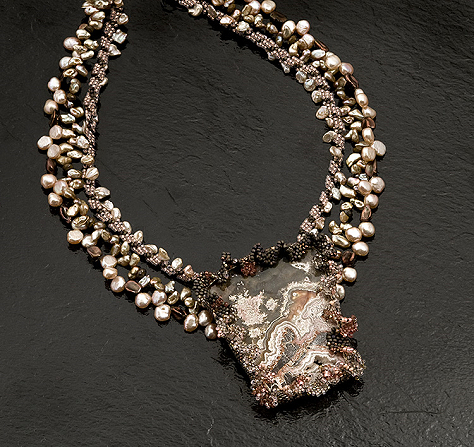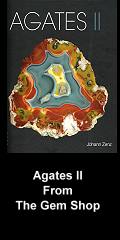
This gorgeous stone is set in sterling (really--check out the photo of the back). Zenz' Agates II indicates that recently very little Crazy Lace Agate, mined in Chihuahua, is coming onto the market. I certainly hope the deposits have not been exhausted! Crazy Lace is named after the lace-like patterns which develop in the stone. The lovely pinks and browns are due to secondary iron oxides in the microcrystalline quartz. This one has a beautiful little drusy pocket at the lower right, contributing a coral reef to the ocean wave image I seem to see in the stone. I softened the form with a ruffle of seed beads, and added strands of pearls and more beadwork to complete the composition.
As a sea kayaker, this stone looks like really big surf pounding against the rocks to me. Under those waves lurk amazing creatures so I put a gray whale on the back. The gray whale migrates past San Diego twice a year on its 26,000 mile round trip to and from its breeding grounds in Baja. Although I'm not aware of any rock art in Anza Borrego which depicts them, I've seen realistic whale depictions in the famous cave paintings in the Baja Sierras (there are photos of them in Crosby's book below).
I once had a young gray whale surface and spout right next to my boat. It was a very dark and beautiful moonless night under the stars on a peaceful sea. In the excitement of the moment (as in WHAT IS THAT?!!) I failed to notice the heart in its characteristic spout so I have attempted to rectify that oversight by carving it into the back of this setting. You can see the whale is perfectly calm under the dizzying waves, a good lesson for us all about seeking depth/wisdom in the midst of superficial challenges. The gray is a baleen whale which uses the bony plates in its mouth to strain small benthic crustaceans out of sediment. Isn't it amazing that a creature which reaches over 50 feet in length eats only such small tidbits? They are sweet, intelligent and curious creatures which often approach whale watching boats in their birthing lagoons in Baja and sometimes seem to enjoy being petted. The one that checked me out didn't wait to be petted, but I would have loved to have spent some time with it. The Medicine Cards give the whale the attribute of "record keeper," carrying the history of Mother Earth, and relates whale song to remembering and to sound healing. Andrews mentions the importance of finding one's own song. Wood let me down, he doesn't seem to mention whales despite Jonah's having been swallowed by one (I was tickled to find this magnificent old reference book is now available in a new paperback edition--see below). Perhaps his omission is explained by France's Encyclopedia which interprets the statement that God prepared the great fish to swallow poor Jonah as meaning that the great fish was a miracle and not a natural species.







